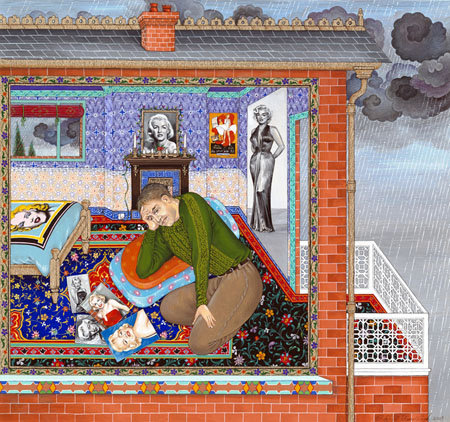Love
dal 23/7/2008 al 4/10/2008
Segnalato da
Raffaello
Jacopo Bassano
Lucas Cranach
Jan Vermeer
David Hockney
Holman Hunt
Marc Chagall
Tracey Emin
Marc Quinn
Rabindra Singh
Stanley Spencer
Joseph Wright
23/7/2008
Love
The National Gallery, London
Comprising works of art from the 15th century to the present day, this exhibition explores how artists have represented this most powerful of emotions. Encompassing divine and mortal love, chaste and unchaste love, family love and charity, it demonstrates how artists including Raphael, Cranach, Vermeer, Holman Hunt, Marc Chagall, Tracey Emin and Marc Quinn have described or responded to love in all its complexities, across the centuries and in a variety of styles.

Arguably the inspiration for great art more than any other human emotion, love nevertheless presents a challenge to the visual artist. How do you depict love? How do you convey its complexity and intensity?
Comprising works of art from the 16th century to the present day, this exhibition explores how artists have represented this most powerful of emotions. Encompassing divine and mortal love, chaste and unchaste love, family love and charity, it demonstrates how artists including Raphael, Cranach, Vermeer, Holman Hunt and Marc Chagall have described or responded to love in all its complexities, across the centuries and in a variety of styles.
Fascinating juxtapositions emerge. Tracey Emin’s 'Those who Suffer Love (I’m OK Now)' connects the agony of the creative process and the intricacies of human relations, looking at tensions similar to those that surrounded Dante Gabriel Rossetti’s iconic 'Astarte Syriaca', painted over one hundred years previously.
From the excitement and aspirations of a newly-formed couple, to the comfort and complicity of a long-standing relationship, each stage of love has its pleasures. Some of these are present in works by Stanley Spencer and Joseph Wright of Derby; more broadly, a work by Marc Quinn considers the perception of couples in society.
The embrace of 'Kiss' questions concepts of beauty and preconceptions about entitlement to affection – while, caught in a moment of passion, the close-knit pair seem oblivious to the outside world.
Paintings by the Singh Twins juxtapose the dissatisfaction of celebrity worship with the joy of love reciprocated; Sir Lawrence Alma-Tadema paints two women whose friendship will be ruined by their love for the same man.
These works serve to remind us that love is not always a source of happiness and can sometimes lead to jealousy and betrayal. In 'Medea' – most dramatically – Anthony Frederick Sandys indicates how Jason’s rejection of the Scythian princess will result in deception and death.
Love’s power to beat all kinds of adversity is also revealed in the exhibition. In 'The Good Samaritan' by Jacopo Bassano, as a traveller tends to the wounds of a total stranger, neighbourly love overcomes racial and religious prejudice. In David Hockney’s 1961 painting 'We Two Boys Together Clinging', meanwhile, a locked embrace suggests how love can grow stronger in a hostile world.
Love is the seventh in a series of exhibitions organised in partnership with Bristol’s Museums, Galleries & Archives Service and Tyne & Wear Museums. The National Gallery Touring Partnership (2006–2008) is supported by the Heritage Lottery Fund, the Northern Rock Foundation, the Esmée Fairbairn Foundation and in London by the Bernard Sunley Charitable Foundation.
Lectures, Courses and Workshops
Wednesday 30 July, 6.30-8pm
Wine, Nibbles and Talk
Love: Introduction
Wednesday 10 September, 6.30pm
Poetry Reading
The Language of Love
Free event
Saturday 13 September, 10.30am - 4.30pm
Multimedia Workshop
Objects of Love
Image: Rabindra Singh, Raining in My Heart (Longing), 2003
-----
The Simon Sainsbury Bequest
Tate Britain, Room 8
Until 5 October 2008
The Simon Sainsbury Bequest to the nation goes on public display for the first time from 8 July to 5 October 2008 at Tate Britain. All eighteen paintings from the Bequest are brought together before entering the permanent collection displays at the National Gallery and Tate. The works, five of which were donated to the National Gallery and thirteen to Tate, were given by philanthropist and collector Simon Sainsbury (1930-2006), in one of the most significant bequests of paintings ever made to the nation.
Comprising outstanding international and British art from the 18th to the 20th century the Bequest covers a variety of subjects from portraits and conversation pieces to still life and landscape. Tate received thirteen works by artists Francis Bacon, Balthus, Pierre Bonnard, Lucian Freud, Thomas Gainsborough, Victor Pasmore, John Wootton and Johan Zoffany. The National Gallery received five paintings by artists Edgar Degas, Paul Gauguin, Claude Monet and Henri Rousseau.
For further press information please contact:
Natalia Yanez-Exner on 020 7747 2596 / natalia.yanezexner@ng-london.org.uk
National Gallery
Trafalgar Square - London
Open daily 10.00-18.00
Admission free



